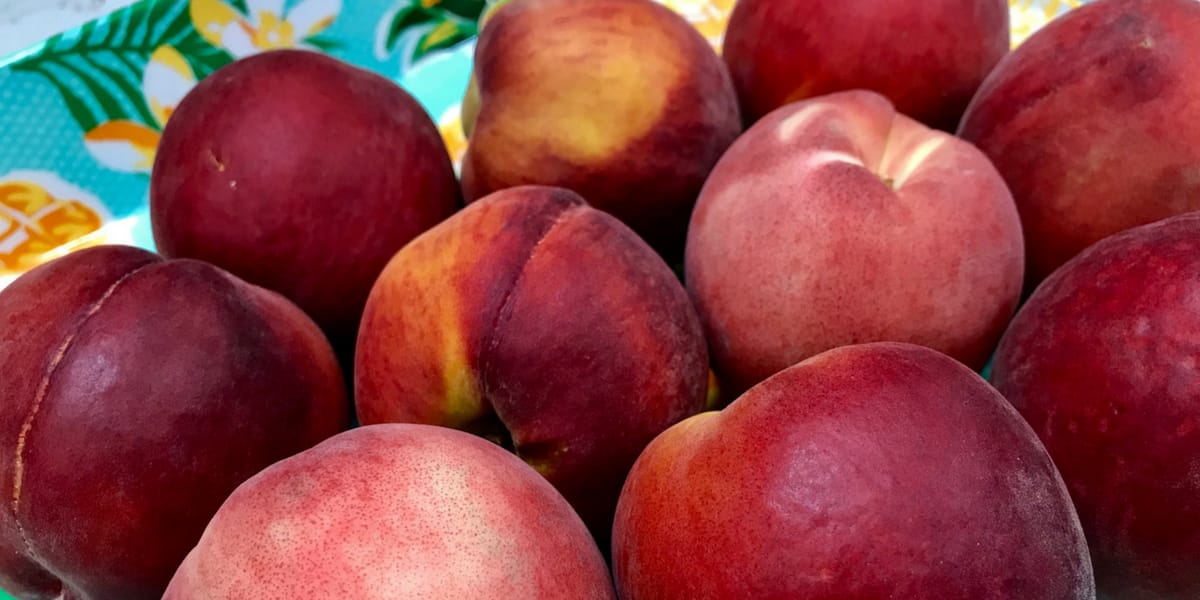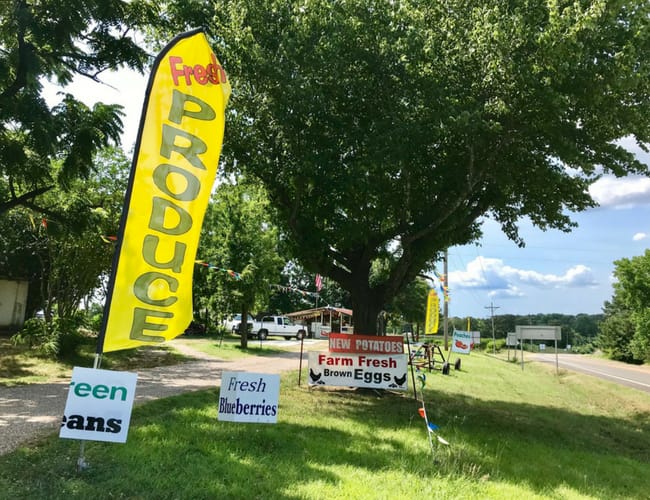

Uh oh...
It appears that you're using a severely outdated version of Safari on Windows. Many features won't work correctly, and functionality can't be guaranteed. Please try viewing this website in Edge, Mozilla, Chrome, or another modern browser. Sorry for any inconvenience this may have caused!
Read More about this safari issue.

This time of year it feels commonplace to see a vegetable stand on the side of the road. Some built of wood, others of metal. Some have seen better days and, some are works of art. The main feature — they are functional!

Growing up, my grandparents lived in a farming community. Both sets of my grandparents had their own gardens, and we always had access to fresh tomatoes and peppers, the melons the birds didn’t get, and occasionally a cabbage or lettuce variety. I’ve tried to follow in their footsteps and grow an herb or two. Even the little kits you get from the store can’t seem to survive on my porch. It’s just not my calling. That’s why I think I’m so fascinated when I see a flourishing orchard.
Just north of DeQueen, in the town of Gillham, I’ve always been intrigued by a fancy little stand on the West side of the road. It’s obvious the land around it is used to grow the produce for sale, and the people who work there are kind and friendly with bare, sun-kissed shoulders and warm, pleasant smiles (and one of the owners has a sweet sleeve tattoo of orchard fruit).
This time of year their peach orchard is bountiful and the watermelons look like searchlights drawing you in. It is really hard to pass a trailer full of shiny green striped shells.
So, on a stop for my weekly peaches, I recently took a few moments to get to know the farmer and the family behind the produce stand in my hometown — Diamond J Orchard and Ranch. Josh Morris is a sixth generation farmer on this same plot of land that was originally a homestead farm in the 1890s.

Arkansas has long been known for its agricultural contribution to the world. From the beginning of the early territorial days, the state was recognized and divided by soil types of 6 different regions. The flooding that came from the Mississippi, Ohio and Arkansas rivers led to a thick, dense, clay-like soil in the Northeast part of the state. This area became known for its flat terrain due to the washing and eroding of this deep soil. This formed land perfect for row cropping in a wetlands environment. Today that land still produces rice and soy that feeds much of the world.
While that portion of the state retained its swamps and shifted dust to form the separation of the Grand Prairie and Crowley’s Ridge, the pre-Columbian Woodland people moved in and formed what we recognize today as food mounds. Here they stored vegetables and grains they grew and harvested with hand-wielded gardening tools. This was a tough way of food production, but it supplemented their hunting lifestyle.
It wasn’t until the 1820s, following the Louisiana Purchase, that this area became known for cotton on the river bed system that naturally developed. Simultaneously, another region of the state was building a soil terrain suitable for a similar type of cropping. The Red River in southwest Arkansas produced a common flooding process like the Mississippi Alluvial region, but it sat higher and therefore left alone the sandy-textured soil of the region versus the clay base of the northeast. Cotton also became the major crop of this region and was at one point the only one grown in fluidity in the area.

Other regions included the Ouachita Mountains/Ozark areas that experienced lots of flooding from the watershed valleys and sterile lands from the erosion over the years. Arkansas’ River Valley remained the most fertile area for the longest period of time and saw profit from a variety of crops.
Initial Homestead Farms in Arkansas began in the early 19th century and were usually producers of cotton, grains, some tobacco (mainly in the Ozarks), a few livestock, potatoes and vegetables. Many were started with 100 acres and were often set on a hillside or other obscure locations. The Southern Homestead Act, signed into law by President Andrew Johnson in 1866, began diversifying the land across the state of Arkansas because much of it was still considered public domain following the war. Towns like Pine Bluff and Helena were settled after the Emancipation Proclamation through assistance from the Freedman’s Bureau and the Homestead Act. However, Arkansas suffered the issues many states did with regard to establishing offices, educating those eligible about opportunities, and regulations. That time was wasted, and public lands were bought up by private entities. The timber industry grew as railroads were brought in through these privately-owned spaces and individual farms were slow to build.
Sharecropping and tenant contracts were established, and those who could have once owned their own farms now had negotiations set up to work larger, established lands. Famers of small land plots found themselves strapped with debt caused by farm establishment and deterioration of crop pricing.
But, in the late 1800s, many Arkansas farmers turned their eye toward a new opportunity — fruit. Apples were in the eye of Northwest Hill country farmers. Peaches were perfection in the Arkansas River Valley soil, extending all the way down into the Ozark area and the Ouachita Mountains toward Howard County. And berries began to grow in success around the White and Little Red River areas.

The Diamond J Orchard and Ranch was established out of these efforts; an original homesteading farm in Arkansas. At the time it was set up and known as Morris Farms, but today their diversification includes cattle, fresh eggs, and fresh honey pulled from 300 hives around Sevier County.
Multigenerational family farming is a big part of why Arkansas agriculture continues to remain healthy. Today Josh works with his mom and other family members for daily harvesting and upkeep during their high fruit season from May through September. They are an established Arkansas Grown farm with produce stands in Gillham, DeQueen, and Hochatown, Oklahoma. But, these are not new establishments. They have had their produce stand at the corner stop in DeQueen for 27 years and the main one on their property in Gillham since 1985. Morris shared that his dad’s grandfather had a produce stand in the 1920s, where he sold many of the same fruits.
“Farming is something you are just born in to. Growing up, you learn the importance of it and are just taught to be a farmer,” Morris said. For the Morris family, it’s been a tradition from the beginning, and it’s something this sixth generation wanted to hold on to and continue to expand. In addition to the bees and honey, they participate in another new project, the Arkansas Farm to School Network. Through this association, they are able to work with local school districts to provide fresh produce for their cafeterias from local farmers, nutrition education through the classroom and working with students in those classrooms to build school gardens. This program also allows them to partner with jails and nursing homes locally for additional healthy menu options.

My journey to the produce stand that day had me seeking out peaches for a cobbler I was making for guests, but while I was there, I learned 4 facts about watermelon picking that he shared with one of his local customers.
- In the field, you can tell a watermelon is ready by the curl on the stem. That’s actually all that they look at to know when one is ready to pull. What they want to see is that the stem is straight until the first leaf and when it’s ready it will start to curl a little bit. That’s when they cut it off the vine and bring it in.
- Scars on a watermelon are a sign that it will be super sweet. The vine has to send extra nutrients to zap the scar and help it heal, and it will turn into a sweet fruit.
- The yellow on the bottom is a good sign. It means it had to sit still in that spot and get a little extra sun kiss.
- And, the myth has been busted — the thump you are listening for when you smack a watermelon is a hollow sound. A “flat” sound means it’s overripe, so you listen for a deep, hollow sound to know you’ve found the right one.
A few extra minutes in the hot summer sun proved to be an educational experience, but now I know my local farmer. While my town has the Diamond J Orchard and Ranch, I bet your town has another local farmer, seeking the same thing — an opportunity to feed his community healthy and nutritious options from the ground and dirt in their own hometown.
Let me challenge you this summer to stop and meet the farmers who grow your food. And, if you are really nice, surprise them with a cobbler made from their own fruit!

Papa’s Cuppa Cobbler
1 stick of butter
1 cup flour
1 cup white sugar
1 cup milk
1 teaspoon baking powder
1 cup chopped peaches (I use peaches, but it would work with plums or berries too.)
Preheat oven to 350 degrees. Melt butter in the bottom of an 8×8 cooking dish (or double for 9×13 pan). In a bowl, mix together flour, sugar, milk, and baking powder. Stir together until all ingredients are incorporated. Pour into pan of melted butter. Sprinkle top with chopped fruit. Bake for 30 minutes or until edges are golden brown and top is set. Serve warm with whipped topping or vanilla ice cream.
Join the Conversation
Leave a Comment
3 responses to “Meet the Farmer: Diamond J Orchard and Ranch”
 Leave a Reply
Leave a Reply
We do the work.
You check your email.
Sign up for our weekly e-news.
Get stories sent straight to your inbox!












 Leave a Reply
Leave a Reply
I am looking for some watermelons
[…] With agriculture being the No. 1 economic driver of the state, farming is not going anywhere. Buying from a local farmer drives local economies and makes a lasting local […]
[…] Diamond J Orchard and Ranch anchor the corridor in the middle of town as a fourth-generation homestead farm with a fruit stand in De Queen, Gillham and Hochatown, OK […]